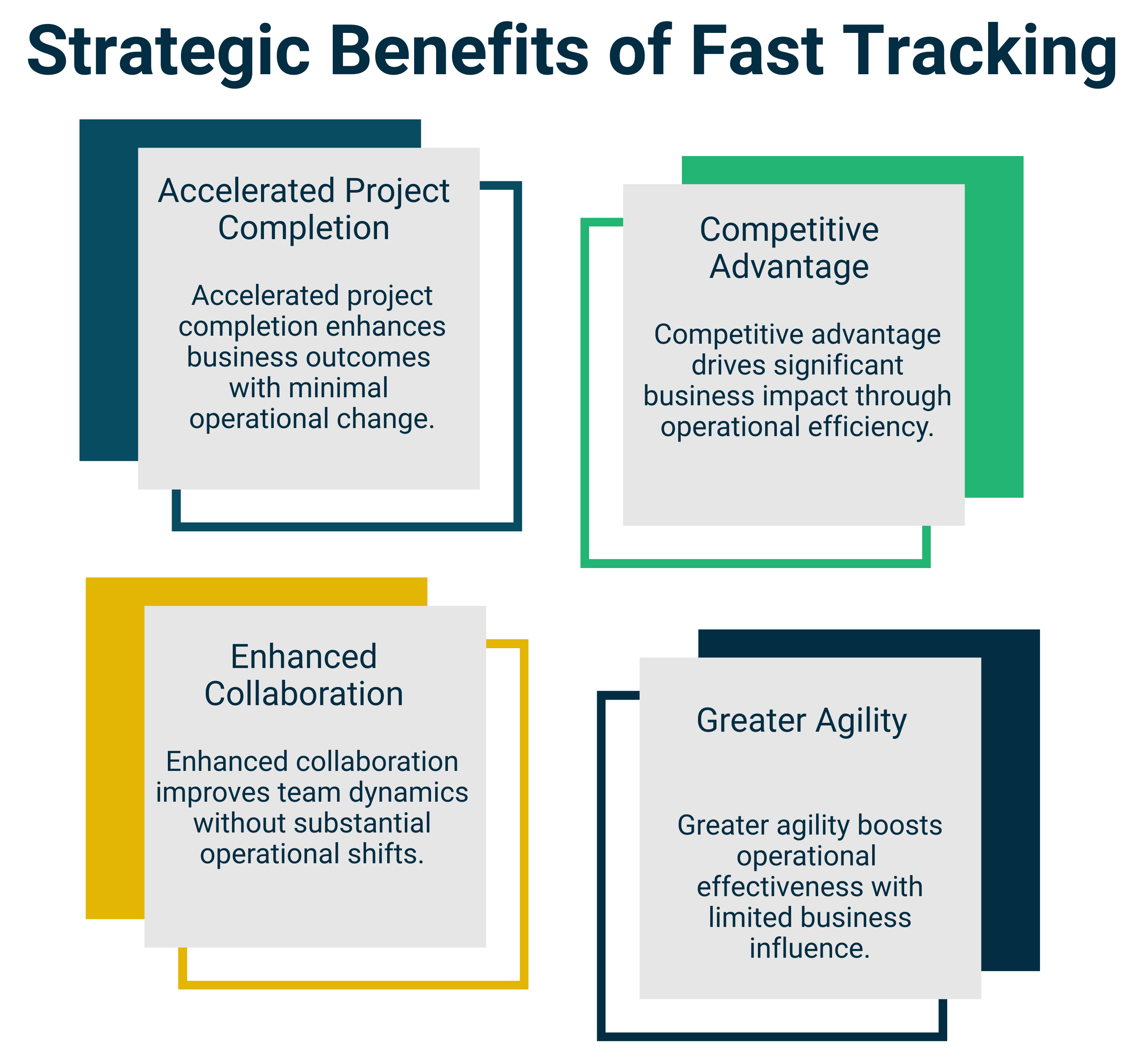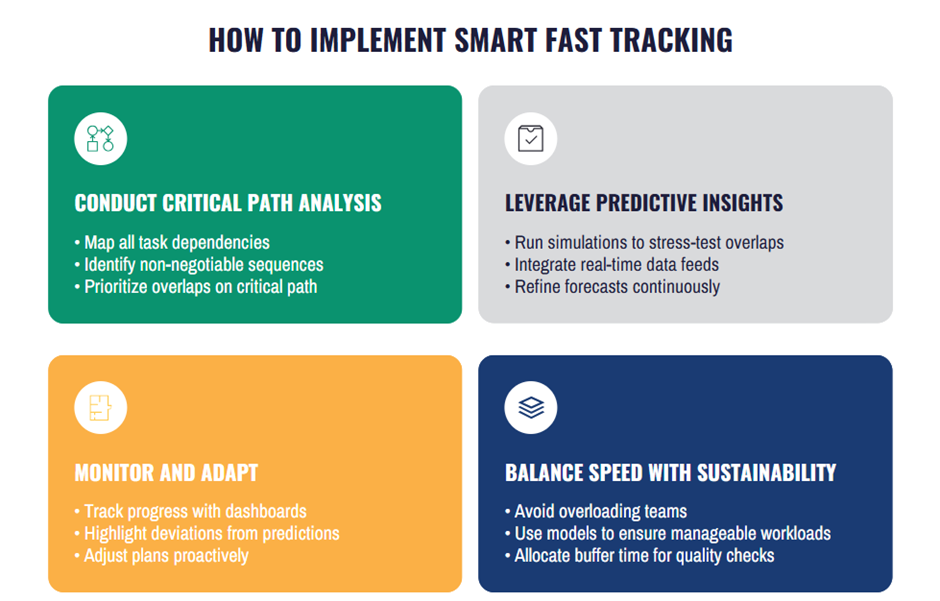
Quick Summary: Fast tracking compresses schedules by overlapping critical-path work with discipline, not haste. It accelerates value creation without disrupting quality or stakeholder confidence when governed by clear dependencies, defined “ready-to-start” gates, risk thresholds, and predictive signals. Without that rigor, it merely trades calendar gains for rework and cost overruns.
Why Fast Tracking Is Now a Core Project Execution Strategy
The recent statistics about project failure rates seem coherent and seamless when combined in a narrative. They consistently highlight that roughly 70% of projects fail globally across industries, with IT projects showing even higher failure rates and average budget overruns around 75%. The data also aligns with major causes such as lack of clear objectives (37%) and poor communication (around 30%).
Furthermore, it shows that larger projects tend to fail more often, and that using formal project management methodologies considerably increases success rates. These statistics come together smoothly to tell a consistent story of the ongoing challenges in achieving project success despite advancements in project management practices.
Project fast tracking has shifted from an emergency fix to a deliberate execution strategy. By reordering tasks so parts of the next activity start before the previous one fully finishes, leaders can accelerate market impact, meet compliance deadlines, and improve cash flow without changing scope. When fast tracking fails, the root cause is usually thin governance, risk, and compliance—unclear dependencies, vague acceptance gates, missing risk thresholds, and no clean path to “de-overlap” if signals turn red.
Why fast tracking matters in modern project management- Competitive windows are shrinking, and coordination costs climb the moment workstreams run in parallel. Modern forecasting lets teams test where overlap delivers value—and where it doesn’t—before committing. PMI research shows well-governed fast tracking can cut schedules by up to 25%, boost resource utilization by roughly 30%, and lift on-time delivery by about 20%. The mandate for executives is direct: run the right tasks in parallel and validate upfront that time saved exceeds the risk of rework, quality issues, and coordination overhead. If a deadline looms this quarter, identify two activities on the current critical path, map a start-to-start overlap, and stress-test it against acceptance gates, capacity, and predicted rework before adjusting the baseline.
![]()
What Project Fast Tracking Is—and Isn’t
What exactly is fast tracking?
Fast tracking is a schedule-compression method that loosens strict finish-to-start links so parts of the next task can begin earlier. The project scope stays the same—only the task logic changes. The Project Management Institute lists fast tracking alongside crashing, resource leveling, and smoothing as a core, disciplined technique, not an improvised shortcut. Focus on the critical path, because overlapping non-critical tasks seldom shortens the overall timeline.
How is fast tracking different from crashing?
Fast tracking adjusts dependencies to create parallelism, typically adding little direct cost while increasing coordination risk. Crashing adds resources or overtime to shorten durations, increasing direct cost but leaving dependencies mostly intact.
When does fast tracking beat crashing?
When budgets are tight, dependencies are truly flexible, and teams can maintain a higher handoff cadence. Choose fast tracking only when the risk-adjusted ROI—time saved minus projected rework, quality cost, and coordination load—is positive; if not, avoid forcing parallelism.
What makes fast tracking work in the real world? ![]()
Treat “good-enough-to-start” as a measurable standard, not a slogan. Distinguish what must be fully complete from what can evolve in parallel. Track project leading indicators—resource heat, early defect trends, dependency violations—to catch issues before earned-value slippage. Keep a pre-agreed rollback to sequential execution ready if thresholds are breached.
“Only 35% of projects are completed successfully, according to Harvard Business Review research. This disappointing rate highlights the ongoing challenges in project delivery and the need for improved project management practices."
Where Project Fast Tracking Benefits and Where It Causes Issues
Fast tracking creates the most value where work can be decoupled without compromising integrity. Globally, only 48% of projects meet classic on-time, on-budget, on-scope targets, underscoring why compressing schedules with stronger oversight is not optional but strategic.
Best use cases for fast tracking in project management
- Modular product or software development - When stable components are ready, system testing can run in parallel while adjacent modules still evolve behind well-defined interfaces.
- Enterprise and infrastructure rollouts - Tasks such as training, vendor enablement, or data preparation often run parallel with integration and environment setup.
- Fixed launch or regulatory deadlines - Where the date cannot move, a governed overlap preserves schedule without cutting scope.
Signals it is the right time:
- Critical-path sensitivity - shrinking one or two tasks materially compresses finish.
- Soft dependencies - sequence is conventional rather than mandatory order.
- Communication bandwidth - teams can absorb more frequent integration checkpoints.
- Favorable history - candidate tasks have low rework propensity and specialists who are not already overloaded.
Where Fast Tracking Causes Delays and Obstacles
- Tight coupling - small upstream changes ripple, magnifying the blast radius.
- Multiteaming saturation - throughput can fall 15–20% when scarce experts split across parallel streams.
- Collaboration drag - with every extra handoff, decision rights become points of delay if escalation lanes are unclear.
Mitigations
- Codify what “good-enough-to-start” means (e.g. API contract frozen, core path tests green, risk mitigations funded, environments ready).
- Instrument overlaps with leading indicators - defect discovery rate, capacity heat, dependency violations.
- Pre-set rollback triggers—e.g. sustained defect trend, utilization breach ≥90% on constrained role—and commit to de-overlap.
Don’t guess your way to delays—see them ahead of time. Book your TrueProject demo.
A Disciplined Project Fast Tracking Implementation Playbook
Fast tracking succeeds when treated like a governed experiment with clear entry and exit criteria. The goal is safe parallelism—overlap just enough work to pull value forward while containing rework and coordination load.
- Lock the baseline
Freeze critical path, dependency types, float, resource calendars, and quality standards. Define this as Scenario A for comparison. - Identify viable overlaps
Scan finish-to-start links that can be reframed as start-to-start or partial overlap. Ask - “What minimum conditions unlock successor safely?” For example - interface contracts frozen, core tests passing, 80% of data mapping, key risks mitigated. - Score the options
For each overlap candidate, quantify end-date impact, expected rework/quality cost based on historical patterns, and capacity pressure on constrained roles or shared environments. Approve only when risk-adjusted ROI is positive. - Pilot with guardrails
Time-box a single stream (module, region, or integration lane). Define measurable success criteria (e.g. ≥10% schedule gain with ≤5% rework premium). Monitor leading indicators - defect discovery, dependency violations, utilization heat, cycle-time variance. - Govern and adapt
Publish risk thresholds and rollback triggers beforehand (e.g. three consecutive negative trend points in defect density or specialist utilization sustained ≥90%). Empower the project lead to “un-fast-track” immediately when thresholds are breached. - Institutionalize learning
Conduct pattern-based retrospectives - which overlaps worked, which didn’t, and why. Convert wins/misses into default acceptance gates and thresholds so predictive accuracy improves each cycle.
![]()
Need a rapid assessment of which projects in your portfolio can safely fast-track? Try the TrueProject SnapShot – https://www.trueprojectinsight.com/snapshot
Avoid common traps - Treating “done” and “good-enough-to-start” as the same; launching successors without documented gates; ignoring single-threaded experts; extending pilots without decision points. Predictive intelligence can simulate overlap options, rank by risk-adjusted time saved, and highlight where stricter guardrails are needed.
Fast Tracking Without Surprises: The Risk Controls That Matter Most
Parallel work introduces distinct failure modes. Durable controls shift left—from detecting harm late to predicting risk early.
- Rework and quality drift
Gate overlaps with measurable criteria (contract tests green on critical endpoints, test coverage thresholds, non-functional risk mitigations). Track defect velocity and severity in overlapped streams; tighten gates at first inflection. Use interface contracts and lightweight integration harnesses so issues show up within hours, not weeks. - Resource contention
Parallel streams compete for scarce roles, tools, environments. Maintain dynamic capacity models; rebalance when thresholds crossed. Limit work-in-process, and stagger meetings so experts aren’t overloaded with syncs across multiple streams. - Dependency integrity
Maintain a dependency ledger with “don’t-break” invariants, owners, key dates. Add change gates that trigger re-evaluation when upstream decisions change risk. Automate checks (e.g. contract/integration tests in CI) so violations show before schedule variance occurs. - Stakeholder confidence
Nonlinear progress can look chaotic to stakeholders used to linear plans. Use dual-view reporting - sequential baseline vs overlapped reality. Pair charts with clear narratives explaining risk posture, thresholds, and what actions will follow if they’re crossed. A transparent decision trail preserves trust. -
Compliance and safety
In regulated environments, minimum gates are non-negotiable. Require independent reviews for high-risk artifacts (security, privacy, regulatory filings), even under schedule compression.
Measuring Fast Tracking: The Metrics That Prove Real ROI
Executives fund fast tracking when it shows its value—not just an earlier date, but a net benefit after rework and coordination overhead are counted.
Core Metrics
- Time saved vs baseline - Compare the finish date of the overlapped schedule vs the frozen baseline.
- Rework / defect cost - Effort, spend, and quality escapes attributable to overlap.
- Budget variance - Extra coordination hours, duplicated environments, rush fees.
- Resource load & utilization - Sustained ≥85–90% on constrained roles signals risk; monitor backlog aging, queue times.
- Stakeholder satisfaction - Milestone ratings on clarity, risk handling, and perceived value.
- Forecast accuracy - Compare predicted vs actual schedule, rework, using error measures like MAPE; adjust models.
How to Use the Numbers
- Decide only when the risk-adjusted ROI is positive.
- Detect early via leading indicators (defect velocity, utilization heat, dependency violations) while fixes are cheap.
- Defend in reviews by presenting time saved alongside rework cost and variance drivers—credibility beats bravado.
Portfolio Learning Loop
Aggregate by pattern (dependency type, domain, team topology), not just by project. For areas where rework is repeatedly underestimated (e.g. cross-vendor integrations, data pipelines), tighten acceptance gates and thresholds. As predictive intelligence systems ingest outcomes, forecasts narrow and become more reliable. Once two consecutive cycles land within ±10% on schedule and rework, scale fast tracking across programs with confidence.
Want to jumpstart fast tracking capability in your PMO? Start with TrueProject SnapShot.
![]()
What’s Next for Fast Tracking: Intelligent Simulation, Adaptive Scheduling, and Predictive Quality
- Intelligent scenario simulation
Modern planning engines now evaluate thousands of dependency and overlap permutations in minutes. They output not just which tasks to overlap, but how far, which gates to freeze, and which thresholds to set to keep rework below defined limits. - Adaptive scheduling in live environments
Static baselines drift. Adaptive schedulers ingest live execution data (cycle times, delays, team capacity shocks) to self-adjust - re-sequence work, throttle parallelism when quality metrics drift, and suggest targeted capacity boosts only where justified. - Predictive quality & sustainability as first-class constraints
Defect leakage, severity mix, contract-test churn, and change hotspots become input signals. ESG and resource footprint considerations also feed into models, e.g. flagging overlaps that multiply environmental or testing overhead unnecessarily. Fast tracking becomes not only faster, but cleaner and more responsible. - Implication for PMOs
Treat overlap decisions as model-backed outputs, not intuition you need to defend. Include project quality explicitly in optimization criteria. Invest in plumbing—dependency maps, execution telemetry, capacity data—because smart overlap depends on rich, trustworthy inputs.
Curious how predictive intelligence would reshape your scheduling and risk forecasting? Schedule a Discussion with our experts.
Project Fast Tracking Built to Endure: Govern, Learn, and Build Trust
Fast tracking has matured from a pressure valve to an operating discipline. Three practices separate durable wins from one-off heroics.
- Govern for foresight
Define acceptance gates, risk thresholds, rollback triggers before overlap. Require two-scenario modeling - baseline vs overlapped with risk-adjusted ROI. Approvals hinge on evidence, not hope. - Institutionalize learning
Closed projects must generate pattern-based retrospectives - which dependency types relaxed safely (e.g. start-to-start on stable APIs), which domains needed tighter gates (integration, data, cross-vendor), and where forecast bias crept in. Feed outcomes into predictive models so each cycle tightens assumptions. - Balance speed with trust
Sponsors bless acceleration when logic is transparent, risk posture visible, and reversibility baked in. Dual-view reporting and plain narratives deliver that. Trust is a KPI—protect it.
Leader’s takeaway - fast tracking isn’t about racing the clock; it’s about controlling the clock—accelerating where data proves value, pausing where risk outweighs reward.
From Insight to Foresight: Predictive Intelligence in Fast Tracking
Why predictive intelligence matters. Predictive intelligence turns schedule compression into evidence-based practice. By learning from historical schedules and ingesting live signals, it forecasts evolving critical paths, quantifies rework probability and likely quality cost before you commit, detects resource heat and dependency violations early enough to adjust, and recommends safe overlap depth with confidence intervals—not guesswork.
Why TrueProject belongs in the toolkit. TrueProject delivers that foresight inside your existing environment. It continuously recalculates the plan to expose where parallelism pays—and where it doesn’t; models risk and quality trade-offs so sponsors see time saved and expected rework premium before approval; surfaces alignment signals (decision latency, assumptions) that derail overlap more often than code; and issues real-time alerts when thresholds are breached, enabling a measured pullback rather than last-minute scrambling.
What leaders gain. Fewer surprises, higher on-time delivery, lower unplanned cost, and a defensible decision trail—because every acceleration was modeled, monitored, and reversible.
Next steps. Run a portfolio snapshot to pinpoint overlaps with the strongest risk-adjusted ROI; launch a time-boxed pilot (one stream, clear gates, explicit rollback) to prove the model in live work; standardize acceptance-gate templates and threshold sets so fast tracking becomes safe by default rather than exceptional by effort.
Don’t wait for quality gaps to surface—see them beforehand. Book your TrueProject demo.
FAQs
1) What is fast tracking in project management?
Fast tracking is a schedule-compression technique that overlaps activities originally sequenced finish-to-start—typically on the critical path—to shorten duration without changing scope.
2) Fast tracking vs. crashing - what’s the difference and when should I use each?
Fast tracking changes dependency logic to create parallelism (low direct cost, higher coordination risk). Crashing adds extra resources or time to existing tasks (higher cost). Use fast tracking when dependencies are flexible and ROI risk-adjusted; use crashing when the budget allows high cost and resource addition yields predictable gains.
3) When should I use fast tracking?
When deadlines are tight, dependencies are soft, teams can handle more frequent integration, and predictive indicators suggest low rework. Ensure constrained roles are not already overloaded (≥90% utilization) and define clear acceptance gates.
4) What are the biggest risks, and how do I mitigate them?
Risks include rework/quality drift, resource contention, and dependency violations. Mitigation via measurable gates, leading indicator tracking (defect velocity, utilization heat, dependency violations), and pre-set rollback triggers that return to sequential execution if thresholds are breached.
5) How do I measure whether fast tracking worked?
Track time saved vs. baseline, rework/defect cost, budget variance, resource utilization, stakeholder satisfaction, and forecast accuracy, comparing predicted vs. actual outcomes. Report risk-adjusted ROI so schedule gains are weighed against real overlap cost.






